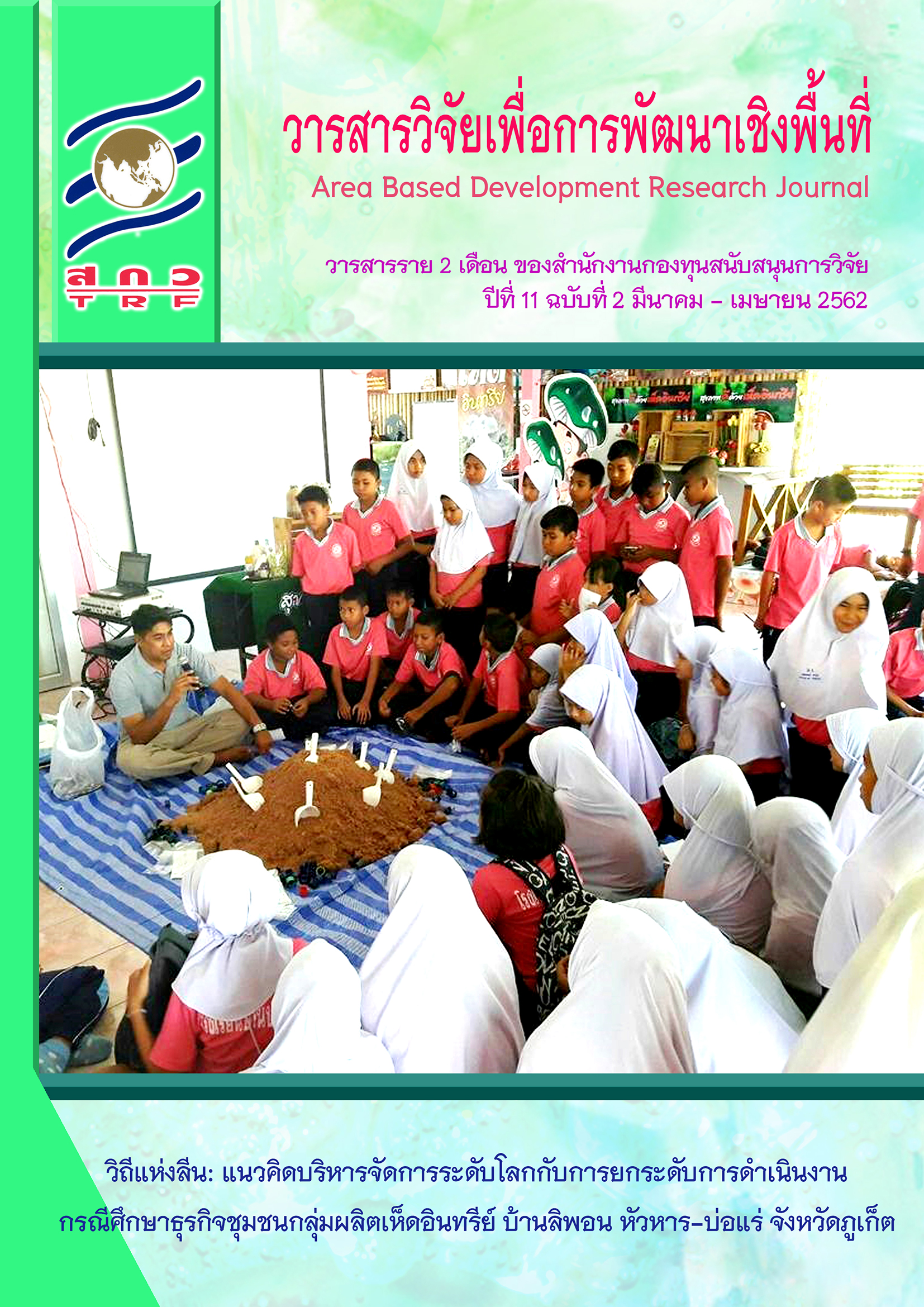Process, System and Styles of Savings Culture in Banthadindang-og Community, Phatthalung Province
Main Article Content
Abstract
The objectives of this research are to study the processes, systems and styles of savings culture for children and youth of one community in Pabon district, Phatthalung province. Data are collected by interviews (informal, semi-structured and in-depth) and observations from 23 key informants who are community leaders, community master plan staff, villagers, and children and youth leaders, who have participated in the activity. Content analysis is then conducted and results are presented in descriptive format. The findings of the Part I - saving process - reveal 4 steps: 1) raising awareness by parents and family; 2) saving practice, depending on individuals’ context, such as children learning on savings from the school and religious doctrine; 3) expansion of savings in multi-dimensional activities, such as planting trees and animal husbandry; and 4) knowledge transfer, such as sharing knowledge with friends. Part II: saving culture systems refer to the three major domains. Firstly, social institution, such as family, temple, school, plays an important role in disseminating knowledge and nurturing a complete human being. Secondly, knowledge and wisdom is a valuable asset when living in a community; for stance, knowledge on plantation and animal farming. Thirdly, transfer of knowledge and wisdom is important as a communication process among community members in order to recognize the value of saving; for example, by demonstrating, storytelling and training. Part III: saving culture styles, consists of 5 styles. The first style is through animal husbandry such as raising cow, pigs, chickens, and catfish. The second style is agricultural savings such as farming, rubber plantation, and eclectic gardening. The third style is by possessing real estate and valuable objects savings, such as land, gold, amulets and ancient objects. The fourth style is intellectual savings such as attending meetings, training courses, study visits, and reading. The fifth style involves monetary savings, such as collecting coins and banknotes in a piggy bank, playing share, and promise money savings. For further promotion of saving behavior, the knowledge and findings from the study will be disseminated to the community.
Article Details

This work is licensed under a Creative Commons Attribution-NonCommercial-NoDerivatives 4.0 International License.
Area Based Development Research Journal values copyright protection and licensing to safeguard author rights and facilitate the appropriate dissemination of research. Our policies ensure openness, accessibility, and attribution. Authors retain copyright ownership, and articles are published under a Creative Commons Attribution License (CC BY), allowing sharing, adaptation, and proper attribution. Authors have the freedom to publish under the CC BY license, granting broad reuse and distribution permissions. The journal supports posting articles on third-party repositories, adhering to institutional and funding restrictions. Author guidelines detail copyright and licensing requirements, empowering authors with knowledge about their rights and responsibilities. These policies cultivate an environment of collaboration, openness, and responsible sharing, benefiting authors and the research community while honoring intellectual property rights.
References
บำรุง บุญปัญญา. (2549). 3 ทศวรรษ แนวคิดวัฒนธรรมชุมชน: บทนิพนธ์คัดสรร ว่าด้วยประชาธิปไตยชาวบ้าน เศรษฐกิจชุมชนและการพัฒนาบทเส้นทางที่เป็นไท. กรุงเทพฯ: โครงการหนังสือดอกติ้วป่า.
พระราชบัญญัติวัฒนธรรมแห่งชาติ. (2485). ประกาศประธานสภาผู้แทนราษฎร. ลงวันที่ 4 สิงหาคม พ.ศ. 2480 และวันที่ 16 ธันวาคม พ.ศ. 2484.
พระราชบัญญัติวัฒนธรรมแห่งชาติ. (2553). ราชกิจจานุเบกษา. เล่ม 127, ตอนที่ 69 ก, หน้า 29–35.
วันชัย ธรรมสัจการ และ พรนค์พิเชฐ แห่งหน. (2561). กระบวนการปรับเปลี่ยนกองทุนการเงินชุมชนสู่ธนาคารหมู่บ้านในจังหวัดสงขลา: บทเรียนในอดีตและปัจจุบันเพื่ออนาคต. วารสารการจัดการ, 7(Special), 74–88.
วันดี หิรัญสถาพร, พรทิพย์ บุญทรง, นงลักษณ์ ลัคนทินากร และ สุรัชฎา เมฆขลา. (2558). พฤติกรรมการออมของนักศึกษามหาวิทยาลัยเทคโนโลยีราชมงคลรัตนโกสินทร์ บพิตรพิมุข จักรวรรดิ. (รายงานวิจัยฉบับสมบูรณ์). นครปฐม: มหาวิทยาลัยเทคโนโลยีราชมงคลรัตนโกสินทร์.
วิโรจน์ เจษฎาลักษณ์ และ ธนภรณ์ เนื่องพลี. (2561). พฤติกรรมและปัจจัยที่มีผลต่อการออมของผู้สูงอายุในอำเภอเมือง จังหวัดนนทบุรี. วารสารวิชาการ Veridian E-Journal สาขามนุษยศาสตร์ สังคมศาสตร์ และศิลปะ, 11(1), 3061–3074.
ศิริรัตน์ ศรีพนม. (2559). ปัจจัยที่มีผลต่อพฤติกรรมการออมเงินของสมาชิกสหกรณ์ออมทรัพย์ครูจันทบุรี จำกัด. (วิทยานิพนธ์ปริญญามหาบัณฑิต). ชลบุรี: มหาวิทยาลัยบูรพา.
สัมพันธ์ เตชะอธิก, วิเชียร แสงโชติ, มานะ นาคำ, และ อกนิษฐ์ ป้องภัย. (2540). การพัฒนาความเข้มแข็งขององค์กรชาวบ้าน. กรุงเทพฯ: เจริญวิทย์การพิมพ์.
เสถียร โกเศศ. (2525). วัฒนธรรมและประเพณีต่างๆ ของไทย. กรุงเทพฯ: สำนักพิมพ์คลังวิทยา.
อนพัทย์ หนองคู และ พรวรรณ นันทแพทย์. (2559). การวิเคราะห์รูปแบบการออมสำหรับวัยสูงอายุในประเทศไทยและต่างประเทศ. วารสารวิชาการการบริหารธุรกิจ สมาคมสถาบันอุดมศึกษาแห่งประเทศไทย, 5(1), 145–153.


